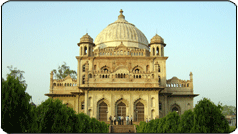Maqbaras of Nawab Saadat Ali Khan and Murshid Zadi
Begum Hazrat Mahal Park (earlier Victoria Park) is actually a place for holding meetings and rallies. Close to this park we find two prominent structures, the mausoleums of Nawab Saadat Ali Khan and his favourite wife Murshid Zadi.
Hailed as an able administrator and builder, Saadat Ali Khan was the sixth Nawab Wazir of Awadh and the last to owe his allegiance to the Moghul King at Delhi. After his death on July 1,1814, his eldest living son Ghazi-ud-Din Haider took over as the Nawab Wazir. Under heavy pressure from the British Resident in Awadtej and the insistence of the Governor General of the East India Company, the new ruler was forced to part with a sum of rupees one and a half crore as loan to the British, to meet the expenses of their military exploits in Rohilkhand and the Gorkha war in Nepal.
As a return for the Nawab's favour, the British encouraged Ghazi-ud-Din Haider to proclaim himself the King of Awadh and declare himself independent of the Moghul rule. In this manner the British were also successful in driving a wedge between these two important Muslim rulers of the country.
Consequently and curiously, to the tune of the British anthem 'God save the King' played by Nawab's native musicians, Ghazi-ud-Din Haider was crowned Shah-e-Zaman, Badshah-e-Awadh, the first King of Awadh at the Lai Baradari on October 19, 1819. The King was honoured with a 21 gun salute provided by a contingent of British and native soldiers.
It was this first king of Awadh Ghazi-ud-Din Haider who had built the grand mausoleum for his father Nawab Saadat Ali Khan. In fact, Nawab Saadat Ali Khan was buried at his son Ghazi-ud-Din Haider's residence which was demolished to build the tomb at Khas Bazaar (later known as Qaiser Bagh).
The floor of the hall of Saadat Ali Khan's tomb is chequered with black and white marble squares. Such flooring is rare among monuments in this part of the country, where marble is scarce. The hall is flanked by rectangular verandahs on its four sides which have arched doorways that open towards the exterior. The verandahs on the south and east have graves that belong to the wives and daughters of Saadat Ali Khan.
The mausoleum has a large hemispherical dome fluted with narrow, regular ribbings. A large guldasta (inverted flower vase) adorns the top of the dome with a finial which is gilded.
Placed diagonally across the mausoleum of Nawab Saadat Ali Khan, on the south-east, is the other mausoleum, that of his wife Mursheer Zadi. Though the construction of this tomb had actually begun in the life time of Nawab Saadat Ali Khan soon after his wife's death, it could not be completed in his life-time. The credit for completion of both tombs goes to Nawab Ghazi-ud-Din Haider.
The twin mausoleums were constructed with the characteristic lakhauri bricks and chunam (specially formulated lime mortar). Embellished and decorated with delicate stucco mouldings and patterns, both the tombs are excellent specimens of Indo-lslamic style of architecture that was patronised by the rulers of Awadh. after the decadence of the Moghul Empire.
Visitors to the city appear more fascinated with the huge and lofty structure of the Great Imambara built by Nawab Asaf-ud-Daulah but as Nand Lai Chatterji, author of Glories of Uttar Pradesh observes 'There is more artistry in them (the twin tombs) than even the Imambara buildings. The latter may be more spectacular, but these two tombs, small though they are, look more graceful and well proportioned. Architecturally, there is little left to be desired except a better material like stone or marble'.
This is true indeed, because had these twin tombs been in stone or marble, few monuments in the country would have surpassed their grandeur and beauty.
Source:
Hindustan Times, City Scan, A Time in History
Wednesday 27.8.1997 — Serene splendour of twin tombs

